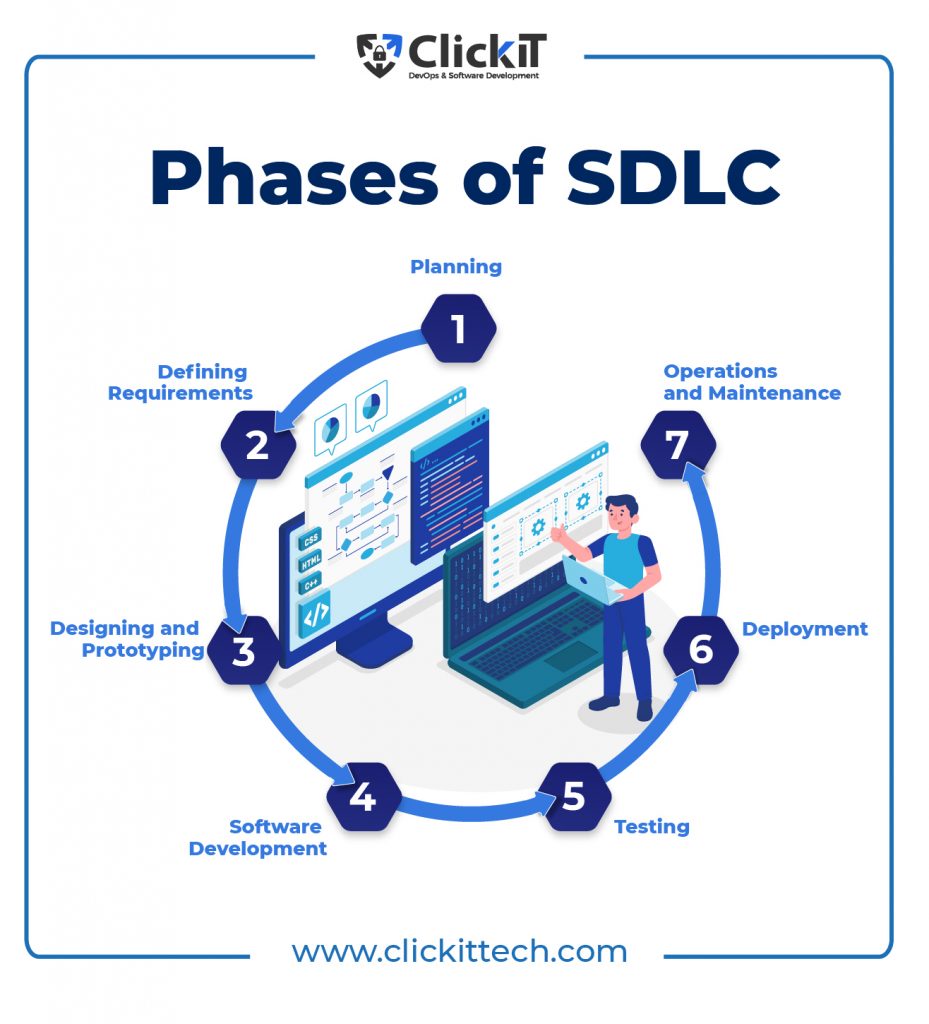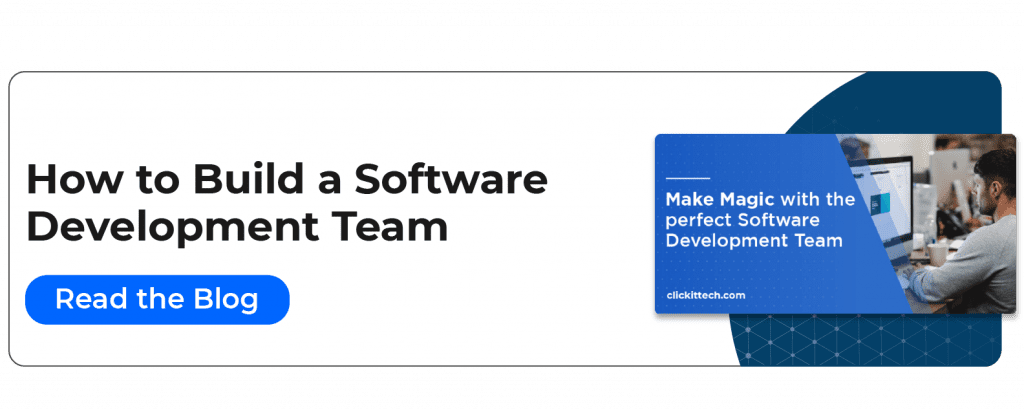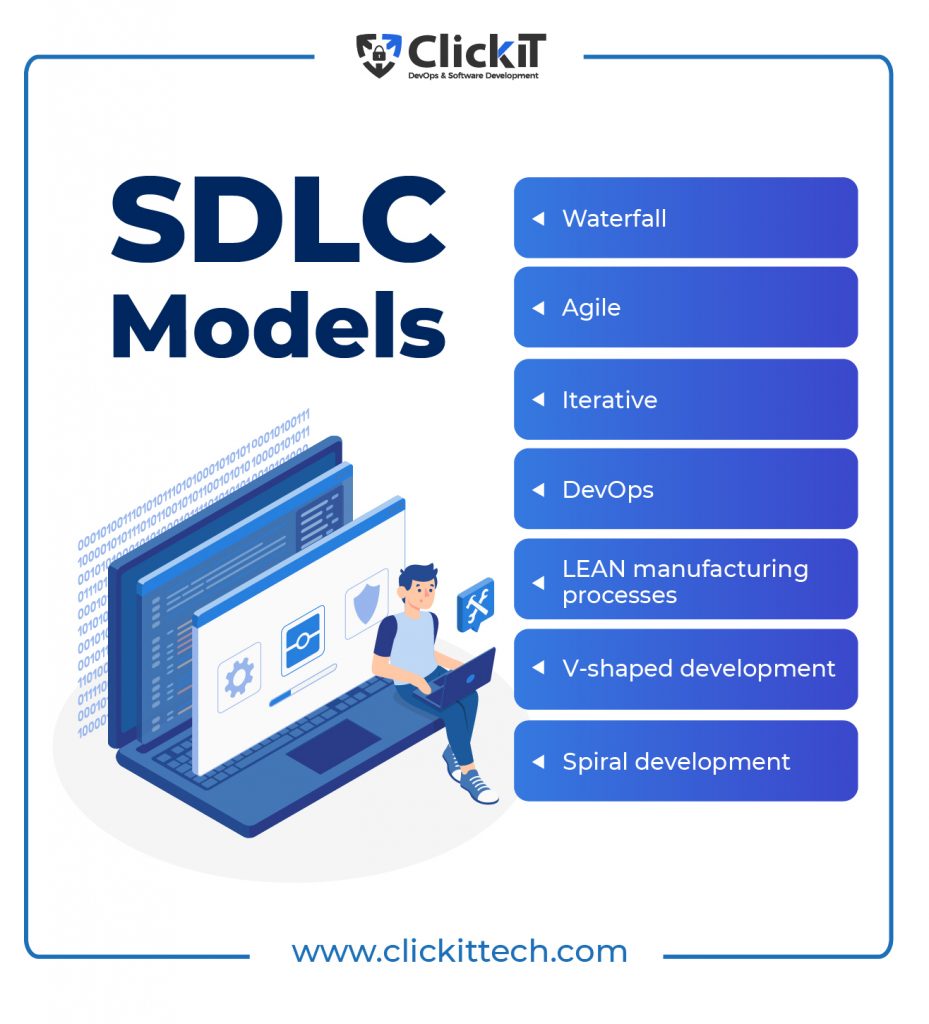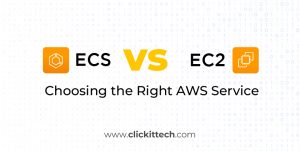To create sophisticated technology, engineers rely on a proper SDLC (software development life cycle). There are many examples of how well-developed software development makes our lives easier, from self-driving cars to smart home devices. This article explains the SDLC examples and how to use it to make your software functional and reliable.
We can now get from one point to another without touching the steering wheel. Or intelligent homes – with a few taps on a touchscreen, you’ll be able to heat up or cool down your home while driving home from work. It’s also used to create simpler applications.
Table of contents
- What Is a Software Development Life Cycle?
- How Does a Software Development Life Cycle Work?
- The Seven Phases of an SDLC
- What are the main SDLC models?
- Best Practices of Software Development Life Cycle
- Increase Productivity and Deliver Products Faster with ClickIT
- Conclusion
- FAQs
What Is a Software Development Life Cycle?
A software development life cycle (SDLC) is the process of planning, creating, testing, and deploying software applications. An SDLC can be described as a list of all the most efficient steps needed to build a software program.
The most significant benefit of an SDLC is making it easier for teams to evaluate and enhance the development process. With this method, every step can be examined in great detail. As a result, businesses may increase productivity at every stage.
By identifying inefficiencies and areas with higher costs and addressing them to ensure smooth operation, an SDLC example allows companies to meet the demands of their clients while reducing expenses.
How Does a Software Development Life Cycle Work?
An SDLC outlines each task required to put together a software application. Aside from helping cut down on waste and making the development process run more smoothly, monitoring also ensures that the project stays on track and that the company can still invest in it.
The Seven Phases of an SDLC (Software Development Life Cycle)
What are the 7 phases of SDLC?
- Planning
- Defining Requirements
- Designing and Prototyping
- Software Development
- Testing
- Deployment
- Operations and Maintenance

1. Planning
The first phase of SDLC is the planning stage, in which the development team creates a roadmap for the project. This means figuring out the costs of labor and materials, setting a schedule with goals, and putting together the teams and leadership structure. They also set deadlines and decide which tasks should be completed and in what order.
This stage should clarify what the application is for and how it will be used. It outlines the processes ahead and gives the team what they need to make the software work. It also defines the project’s limits, so it doesn’t get too big or lose sight of its original goal.
This phase can determine the outcome of the rest of the project. If the planning stage is not done correctly, it can lead to delays and cost overruns.
2. Defining Requirements
In the software development life cycle phases, we have the second stage of an SDLC example, which involves defining the requirements. The development team identifies what the software needs to do and what it should be able to accomplish. They also gather information about the user’s needs, determine the software’s features, and identify any associated risks.
For instance, a social media app needs a feature allowing users to connect with friends, while a program for managing inventory might need a search function.
The resources needed to build the project are also listed in the requirements. For example, if a team works on software for controlling a custom manufacturing machine, the machine should be listed as a requirement in the process.
3. Designing and Prototyping
In the third stage of an SDLC, the development team models how the software will work. Designing often includes:
- Software architecture
- User interface
- Platforms
- Security
- Communication
This phase may also include creating a prototype (an early software version). Stakeholders can look at this “hands-on” design to provide feedback and improve the application.
4. Software Development
The actual code for the software is written during this phase. The development team takes the designs from the previous stage and writes the code to make the software work.
Depending on the project, the development phase can be carried out using different methodologies. For example, a company may use a “waterfall” approach, wherein all the requirements are gathered at the beginning of the project. Then, each phase is linearly completed one after another.
Other companies use an “agile” approach, which allows for more flexibility and iteration. Requirements are gathered, and the team goes through development, testing, and feedback cycles to improve the product.

5. Testing
After the software is developed, it must be tested to ensure it works correctly. Test cases are executed, and bugs are found and fixed. This is an essential step because it helps check that the software is working as intended and that there are no critical errors.
Testing can be done manually or automatically. In manual testing, a human executes the test cases. Software tools are used to run automated testing.
6. Deployment
And in the software development life cycle phases, we have the software is tested and all bugs are fixed, it is ready to be deployed. This means that the software is moved from the development to the production environment.
During the deployment phase, users can start using the app. Many businesses like to automate the deployment process. This can be as easy as placing a payment portal and a download link on the company’s website. It could also mean getting an app on a smartphone.
7. Operations and Maintenance
The final stage of an SDLC example — operations, and maintenance — comes after the software is finished and already being used in the field. At this point, the software may still need updates, changes, or security patches.
Bugs that weren’t found during testing are typically discovered and reported by real users at this time. These mistakes need to be fixed, often resulting in new rounds of development.
The operations and maintenance phase is part of the cycle because it ensures that the software is always running smoothly and that users have the best experience possible.
Now, let’s dive into the software development life cycle examples.
Read our blog Product Manager vs product owner
What are the main Software Development Life Cycle (SDLC) models?
Now that we’ve covered the basic information about an SDLC let’s take a more in-depth look at some software development life cycle examples and methodologies used to carry out the cycle.
- Waterfall
- Agile
- Iterative
- DevOps
- LEAN manufacturing processes
- V-shaped development
- Spiral development

Waterfall
The waterfall model is the most traditional and straightforward approach to software development. In this model, each phase of an SDLC is completed linearly, one after another.
This means that all requirements must be gathered at the beginning of the project before any coding can begin. Before continuing to the next step, each phase of the waterfall model can be checked for continuity and viability.
The approach is most suitable for projects where the requirements are well understood and are not likely to change.
Agile
The agile model is an SDLC example that can be described as a more flexible and iterative approach to software development. It prioritized customer needs, focusing strongly on user experience and input.
In this model, requirements are gathered, and then the team goes through the development, testing, and feedback cycles to improve the product. This means that coding can begin before all the requirements are gathered.
Iterative
The iterative model is a combination of the waterfall and agile models. In this model, the project goes through development, testing, and feedback cycles, just like in agile.
However, unlike agile, all the requirements are gathered at the beginning of each cycle. This means that there is some overlap between phases, but each step is still completed one after another.
Thi software development life cycle example suits projects where the requirements are well understood but may change slightly over time.
DevOps
One of the software development life cycle examples is the DevOps model is a relatively new approach that focuses on collaboration between developers and operations teams – the people who use the software. In this model, both the development and operations phases are completed in parallel.
This overlap leads to more continuous software delivery. The input from actual software users on the design and implementation processes is a key benefit of this methodology. Its requirement for active cooperation and communication is one downside.
The DevOps model is best suited for projects where there is a need for continuous delivery.
Other SDLC Examples
There are many other models and methodologies for software development, including:
- LEAN manufacturing processes
- V-shaped development
- Spiral development
The example or methodology you choose should be based on the specific needs of your project. If you’re unsure which one is right for your organization, you can always consult with a software development company to get their expert opinion.
Best Practices of Software Development Life Cycle
Now, let’s take a look at some software development life cycle best practices that will help you get the most out of this process.
Source Control
Using source control is one of the best ways to manage your codebase and keep track of changes. Source control allows you to have different versions (or branches) of your code so that you can go back and forth between them.
It also makes it easy for multiple developers to work on the same project simultaneously since they won’t overwrite each other’s code.
Continuous Integration
Continuous integration refers to merging all developer working copies with shared mainlines several times a day.
This practice helps you avoid conflicts between different code versions and allows you to get feedback on your code more frequently.
SDLC Management Systems
Many software development life cycle management systems are available, such as Jira and Asana. These tools can help you track your project’s progress and keep all your team members on the same page.
Read our blog, Top SaaS Tools for business, to learn more tools that can help your team.
Increase Productivity and Deliver Products Faster with ClickIT
At ClickIT, we understand the importance of having a well-defined software development process. That’s why we offer a wide range of software development services to help you increase productivity and deliver products faster.
Our experienced professionals will help you with everything, from gathering requirements to testing and deployment.
Here’s what you should know about our team:
- We hire ”A” players — fully vetted and evaluated software engineers.
- We provide end-to-end agile software development, from design and architecture to implementation.
- We offer immediate support, shorter feedback loops, live collaboration, and higher productivity.
Unsure whether ClickIT is the right partner for you? Check out ClickIT reviews on Clutch.
Contact us today for a free consultation! We’ll help you assess your needs and develop a custom software development plan tailored to your unique business goals.
Conclusion of Software Development Life Cycle
The software development life cycle involves designing, creating, testing, and maintaining software. You can see what’s going on and exactly where your development process needs to be improved with the help of an SDLC.
The goal of this process is to evaluate and enhance the software development life cycle phases. An SDLC creates a scalable view of the project, from managing production dates to day-to-day coding.
There are numerous SDLC examples or models for software development, so you should choose the one that’s right for your project.
If you need help with your software development project, ClickIT can provide the expertise and resources you need to succeed.

Software Development Life Cycle FAQs
There is no one answer to this question, as it depends on the specific needs of your project. However, some elements of an SDLC include source control, continuous integration, and management systems.
The software development life cycle is not waterfall or agile. An SDLC is a process that can be used in conjunction with different software development models, such as waterfall or agile.
There are more than 50 different models for software development. The most popular ones are waterfall, agile, DevOps, V-model, Scrum, Kanban, and Spiral.
An example of an SDLC would be a process that includes gathering requirements, designing, implementing, testing, and deploying software.








